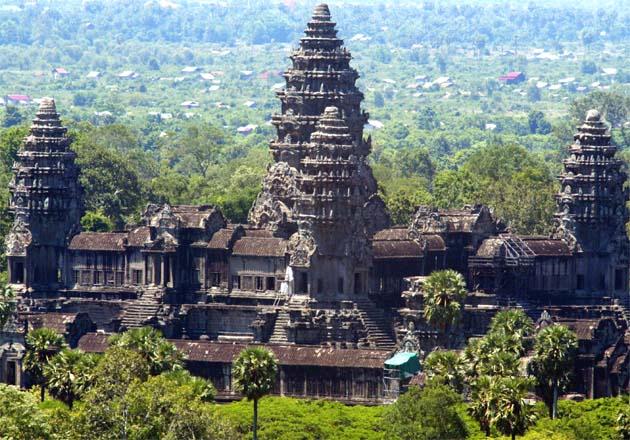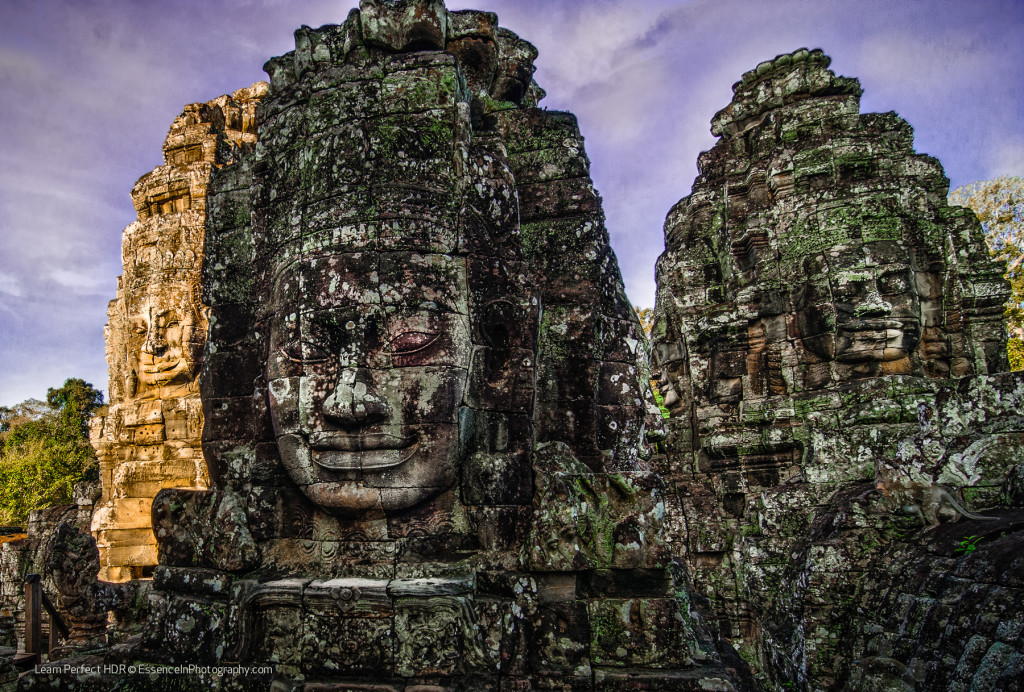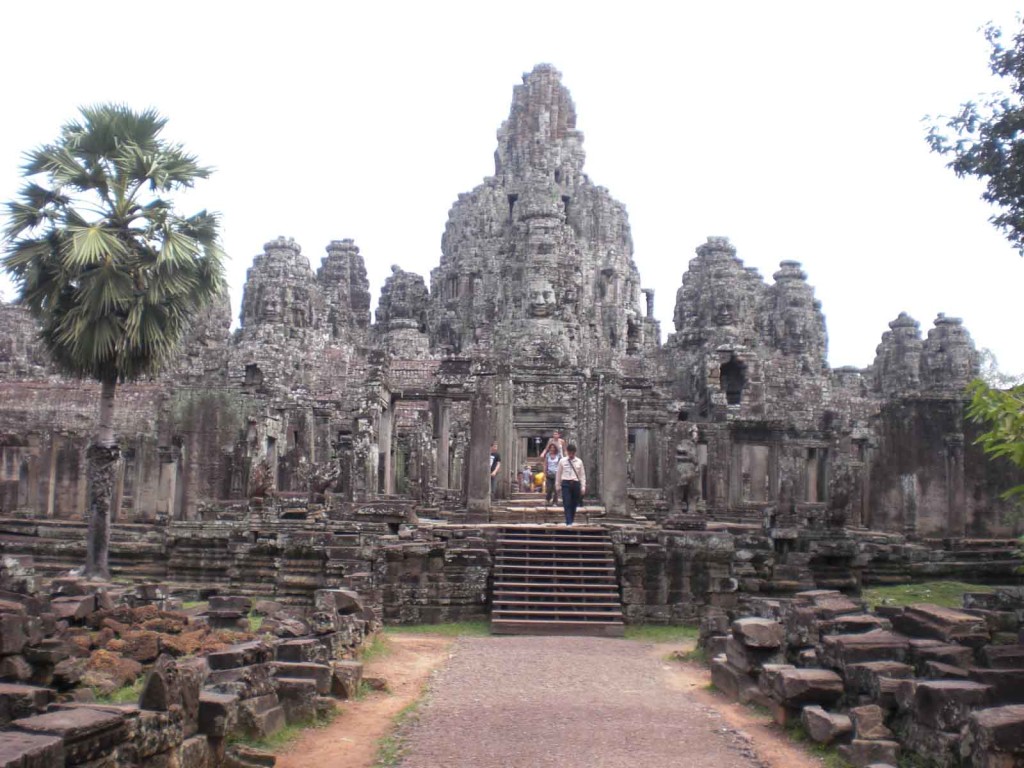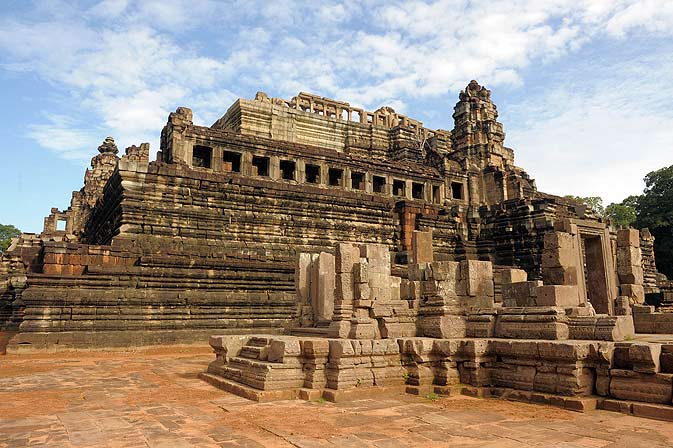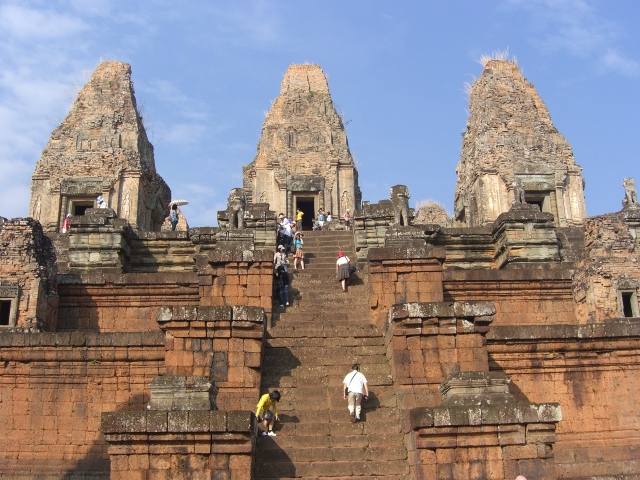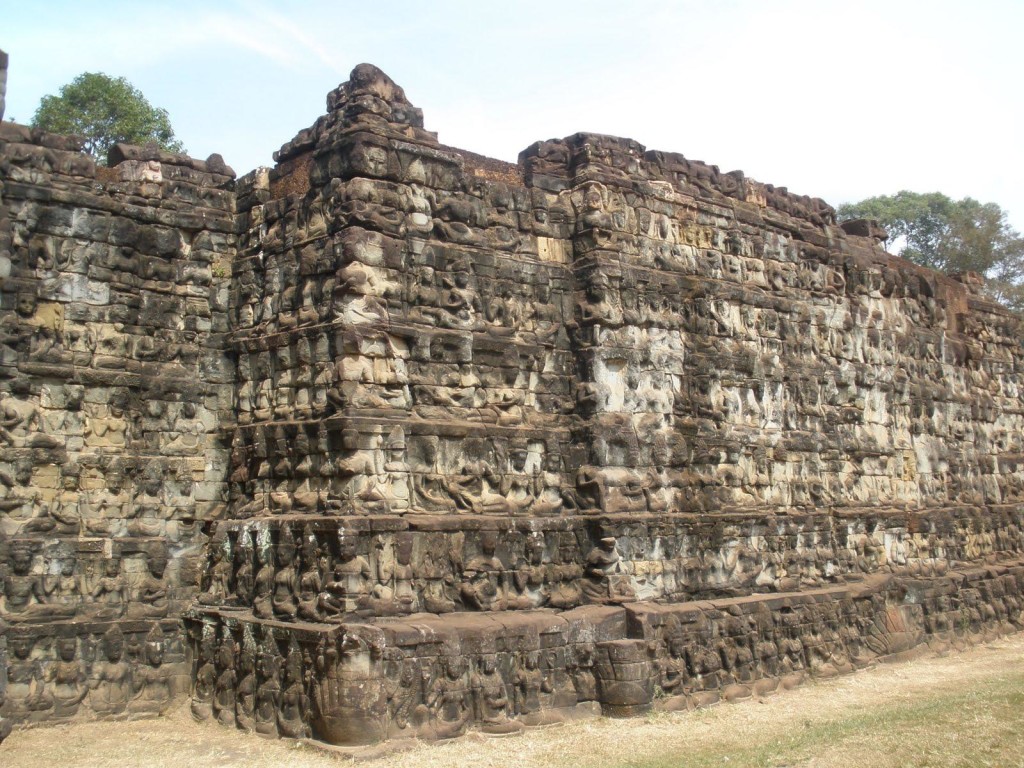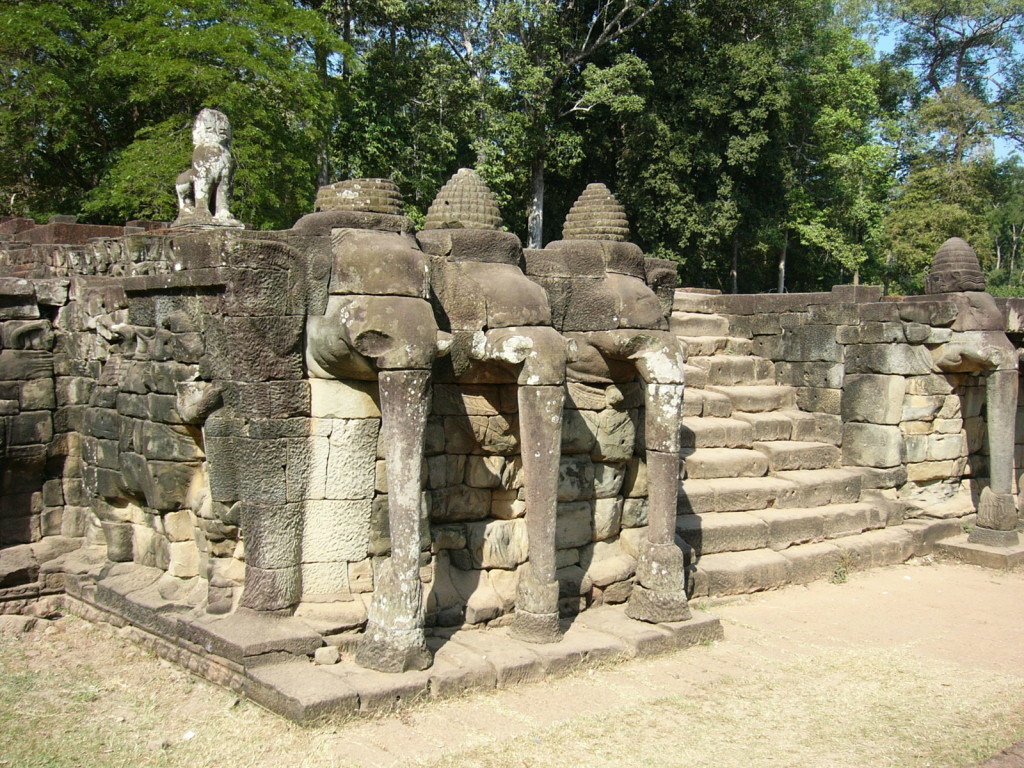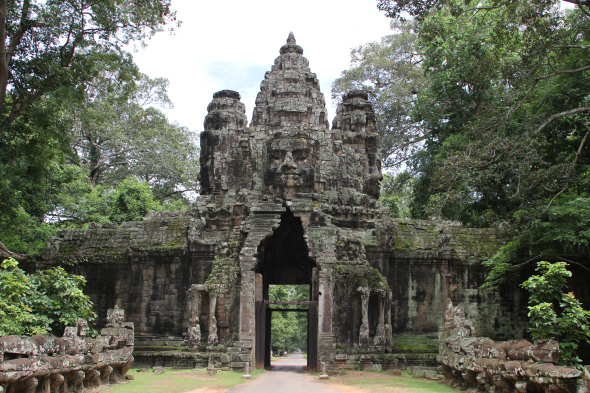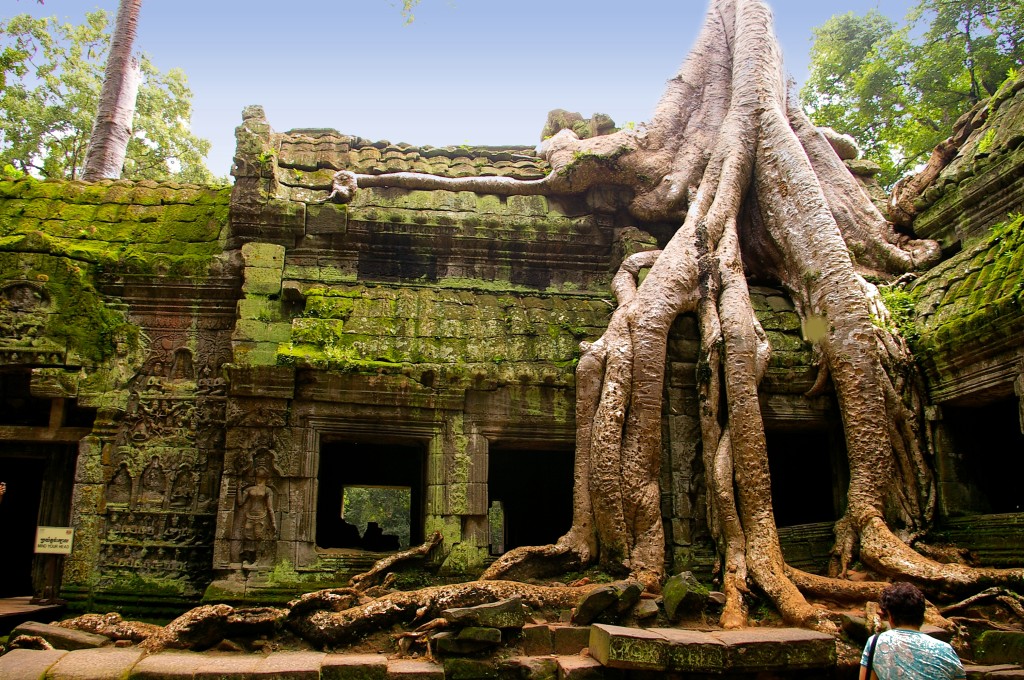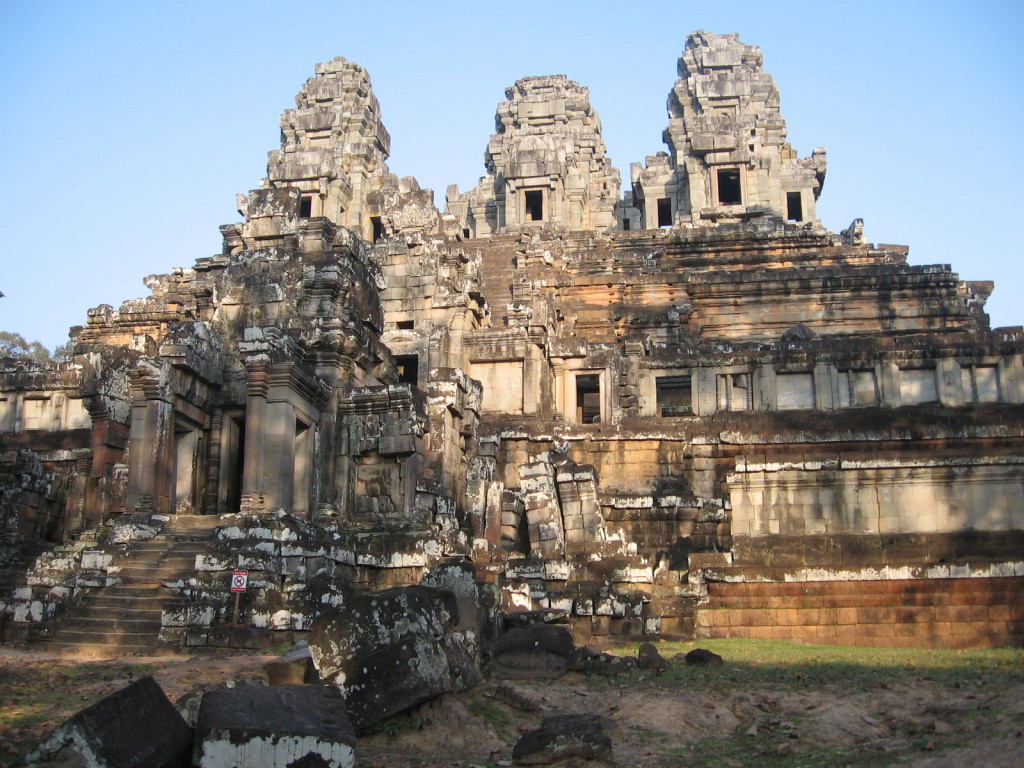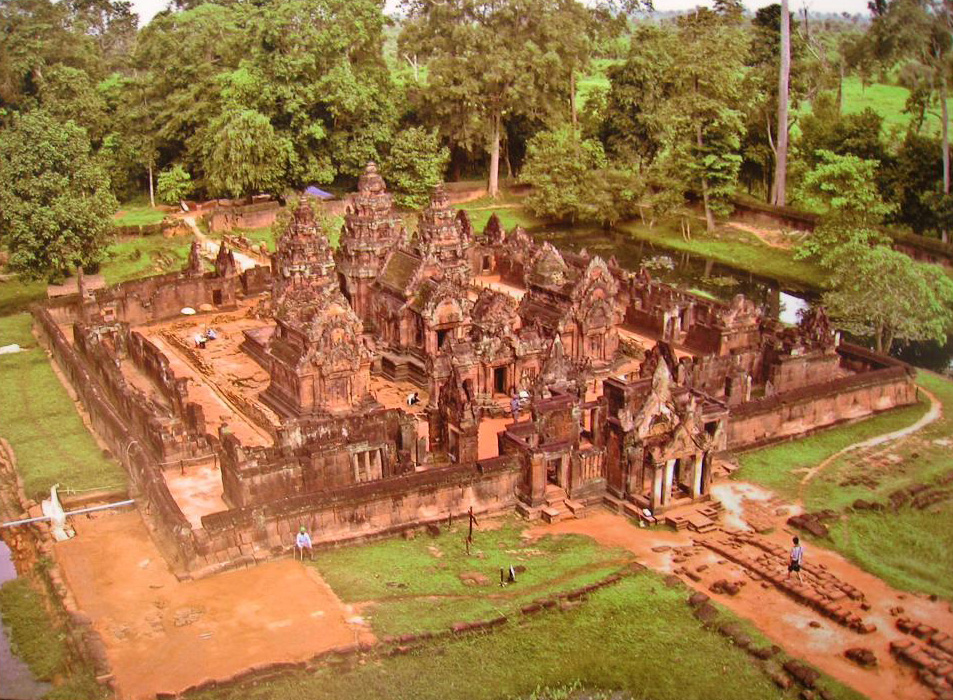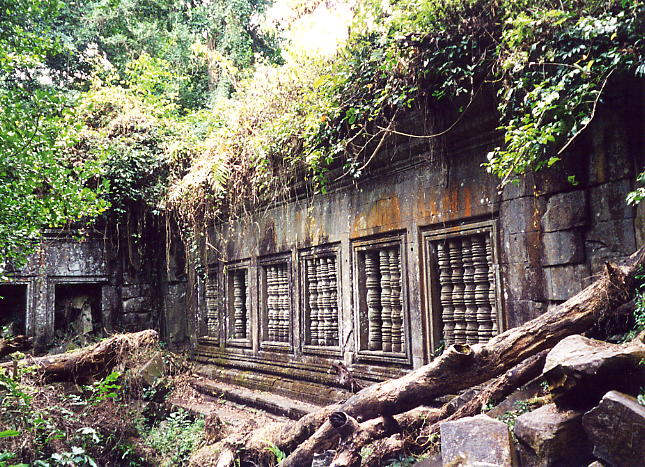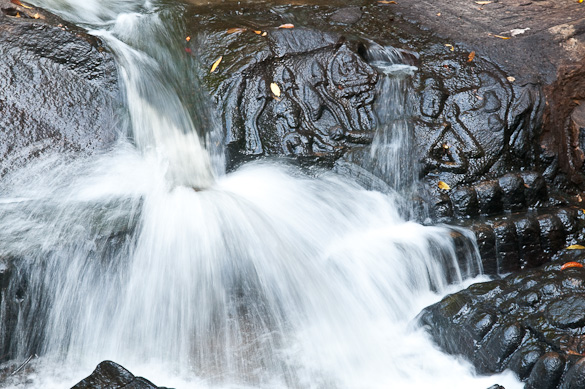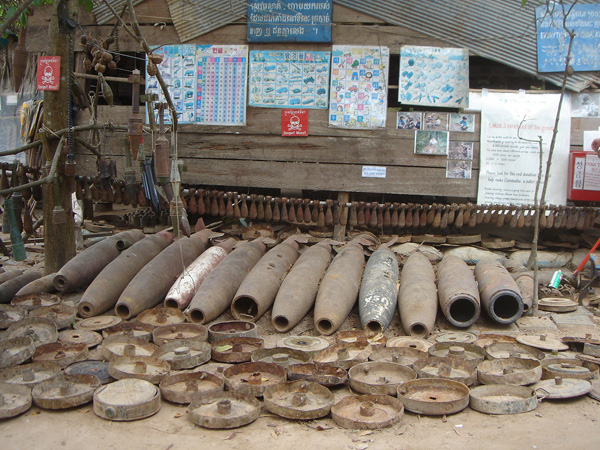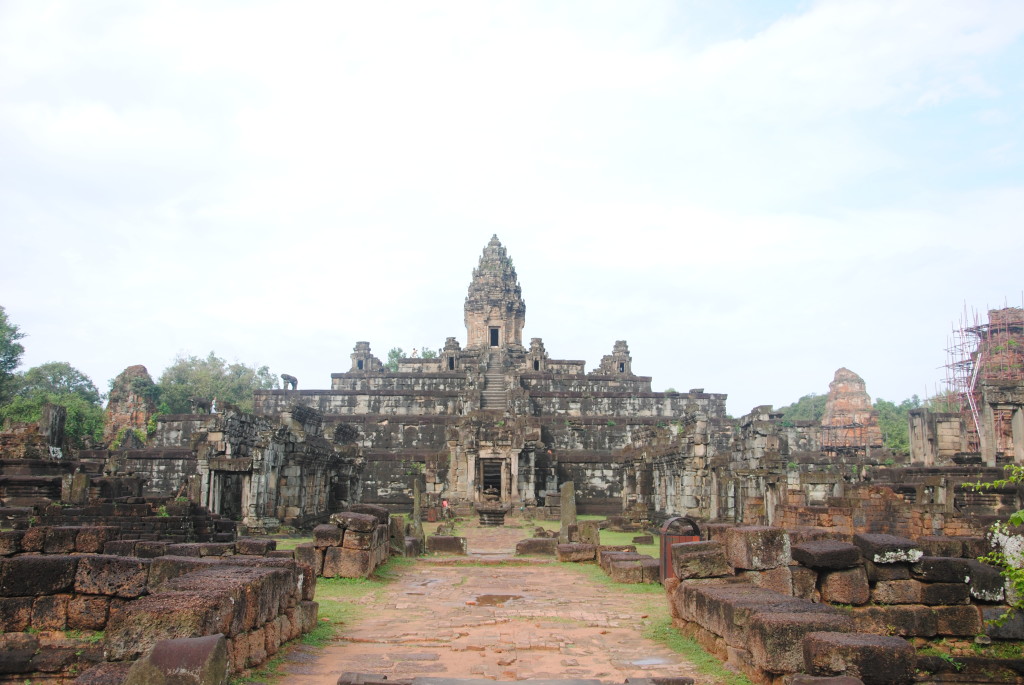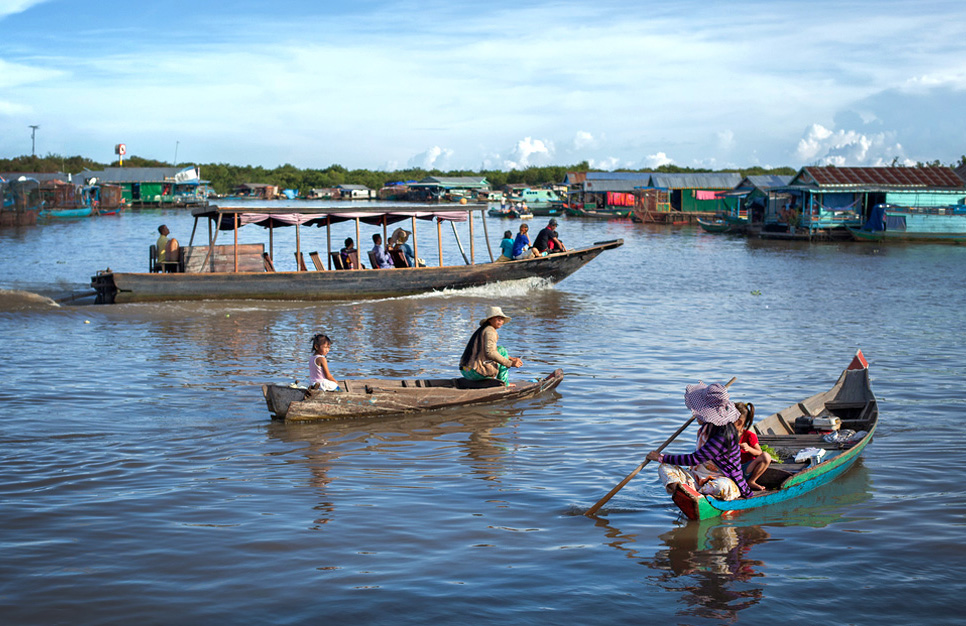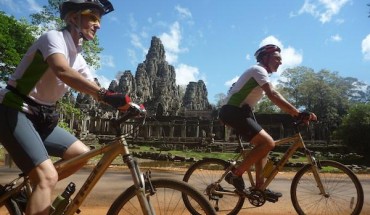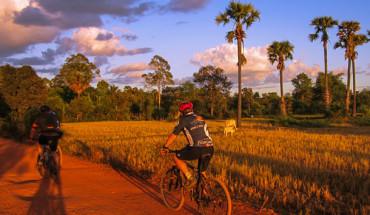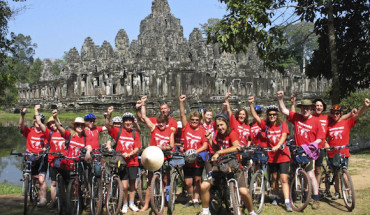Angkor Wat is the Disneyland of Buddhist temples in Asia. The temple complex requires a few busy days to get around the major sights thoroughly. Everyone has a favorite, but I’ve highlighted a few must-sees below. Plan carefully and catch a sunrise or sunset from one of the more prime spots; it’s a photographer’s dream.
Note: The temples are magnificent, and days spent clambering around the temples are inherently interesting, but be careful not to come away from a visit to ancient Angkor with a memory of an oversize rock collection or jungle gym. There’s much to learn about Buddhism, Hinduism, architecture, and Khmer history; it’s useful to hire a well-informed guide or join a tour group. There are also subtleties to temple touring, and a good guide is your best chance to beat the crowd and catch the intricacies or be in the right place for the magic moments of the day. Contact any hotel front desk or the tour agencies listed earlier.
The Temples of Angkor
Our strongest recommendation is to get a guide, at least for 1 day of temple touring. A guide not only provides the most useful information that will serve as a background for your further exploration, but makes the logistics of that first day much easier. Contact any hotel front desk or tour office, and they can arrange something for you. Guides are certified and come from the same school, and so dispense nearly the same information, but, of course, some are better than others. Ask around for recommendations.
Tip: The temple sites listed below are more or less in the usual order you might visit them on tour. A visit to Angkor is now a noisy romp among large Korean, Thai, Chinese, and European groups. An average guide will take you along in the heart of the herd, following the standard temple routine, but a good guide knows how to get you out of the pack. Insist on it.
Important note: The Angkor complex is currently undergoing massive restoration. Most of the temples noted below are included in the extensive project, and as such, certain sections are hidden behind scaffolding or closed off to visitors. While it is disappointing, the restoration is not so invasive as to warrant canceling your trip here. Work should wrap up sometime in 2010.
Angkor Wat
The symbol of Cambodia, the five spires of the main temple of Angkor are known the world over. In fact, this is the most resplendent of the Angkor sites one certainly not to miss even in the most perfunctory of tours.
Built under the reign of Suryavarman II in the 12th century, this temple, along with Bayon and Baphuon, is the very pinnacle of Khmer architecture. From base to tip of the highest lower, its 213m (699 ft.) of awe-inspiring stone in the definitive, elaborate Khmer style. The temple moat is 1.5×1.3km around and 90m (295 ft. ) wide, crossed by a causeway with long naga statues on each side as railings from the west; in fact, Angkor is the only temple entered from the west (all others from the east). Angkor Wat is the only Angkor monument that is a mausoleum all others are temples or mon-asreries. Angkor’s main temple is dedicated to Vishnu.
Approaching the temple, you’ll first cross the causeway over the main moat restored in the 1960s by the French. Enter the compound across the first gallery, the Majestic Gallery, with some carvings and Brahma statuary, and then pass into the large, grassy courtyard housing the main temple. This next causeway is flanked on either side by two small library buildings, as well as two small ponds. (Hint: Hop off the causeway and take a photo of the temple reflected in the pond on the right).
An outdoor staircase sits at the approach to the main temple. From there, you’ll enter the richest area of statuary, galleries, and bas-reliefs. The famous bas-reliefs encircling the temple on the first level (south side) depict the mythical “Churning of the Ocean of Milk,” a legend in which Hindu deities stir vast oceans in order to extract the elixir of immortality. This churning produced the Apsaras, Hindu celestial dancers, who can be seen on many temples. Other reliefs surrounding the base of the main temple show Khmer wars, and corner towers depict Hindu fables.
The most measured and studied of all the sites, Angkor Wat is the subject of much speculation: It’s thought to represent Mount Meru, home of Hindu gods and a land of creation and destruction. Researchers measuring the site in hat, ancient Khmer units of measure, deduce that the symmetry of the building corresponds with the timeline of the Hindu ages, as a map or calendar of the universe, if you will. The approach from the main road crosses the baray (reservoir) and is an ascending progression of three levels to the inner sanctum. The T-shirt hawkers are relentless, and the tricky steps and temple height are a challenge to those with vertigo, but the short trip is awe-inspiring and the views from the top are breathtaking. Note: There’s a guide rope on the southern face (and often a long line up).
It’s a fair walk up to the second level, a flat, open space that overlooks the main temple square, the famed Angkor prangs or parapets on each corner. From here, it’s a steep climb (use the staircase with roped handrail on the south side of the temple) up to the third and final level (at the time of writing, this level was closed to visitors). There are four large courtyards surrounded by galleries, and balcony overlooks from the base of the prangs at each corner. These high perches are great for watching the sunset over Bakeng Hill (though, lately, the guards try to get more folks down earlier and earlier).
Angkor Wat is the first temple you pass when entering the temple complex, but depending on your guide, you might save it for the evening and head directly to nearby Angkor Thom.
Bakeng Hill
Just past Angkor Wat, Bakeng Hill is meant to resemble Mount Meru, the center of the earth in the Hindu cosmology. The hill makes a great spot for sunrise or sunset-viewing and gets crowded like a mosh pit in high season. The hike up is a good way to limber up and break a sweat predawn, but the crumbled steps and slippery mud are a bit much for some. Consider taking the trek in style high upon an elephant’s back in a gouda.
Angkor Thom
The temple name means “The Croat City” in Khmer and is famed for its fantastic 45m (148-ft.) central temple, Bayon, and nearby Baphuon. The vast area of Angkor Thom, over a mile on one side, is dotted with many temples and features; don’t miss the elaborate reliefs on the Bayon’s first floor gallery or of the Terrace of the Leper King and the Terrace of Elephants. The Angkor Thom Gates, particularly the south gate, is good examples of the angelic carving of the Jayavarman head, a motif you find throughout the temple sites. The bridge spanning the moat before the south entrance is lined with the gods and monsters said to have been in competition to churn the proverbial sea of milk that would cause creation of the world. The line of statues with the gate in the background is a classic Angkor scene.
The Bayon
The Bayon is the larger Angkor Thom city and, with its classic carved faces, is one of the best loved of the Angkor temples. Bayon is a Buddhist temple built under the reign of prolific Jayavarman VII (A.D. 1190), but the temple was built atop a previous Hindu site and adheres to Hindu cosmology; with its central tower depicting Meru and its oceanic moat, it can be read as a metaphor for the natural world. The Bayon is famous for its huge stone faces, usually set in groups of four around a central prang, or tower, and each face indicating an ordinal direction on the compass. The curious smiling faces are done in deep relief at Bayon and also in different forms at the entrance gates to Angkor Thom, at Ta Prom, and at Banteay Kdei and the image is the enigmatic Mona Lisa of Southeast Asia, at once recognizable as an image of compassion and equanimity. The face is also said to depict Jayavarman VII, the temple’s very builder and benefactor. You approach the Bayon along a forested area at the city center, cool and misty, where streams of light come through in visible rays and the drone of cicadas is deafening (you might even see some monkeys). Elephant trekkers also line the road to the temple.
The three-level Bayon is nearly square. The first level is surrounded by an intricate bas-relief gallery depicting stories of Khmer conquests and battles, as well as daily life and ritual among the early Khmers. A good guide can lead you to the juicy bits of the fun story, and you can spend a good bit of time sorting out the details for yourself, too (kids love it). Look for the unique pairs of Apsara dancers on columns near the gallery (Apsaras usually dance alone). On the South Wall, find three tiers depicting Khmer battles with the Cham from 1177 to 1181, a battle that took place on the waters of the Tonle Sap Lake in boats look for the grisly images of crocodiles eating the carcasses of the fallen. Also note the Chinese figure with beard, top knot, and lance on a horse. Khmer soldiers ride elephants and have short hair, a spear, and a magic string for invincible fighting; they also carry shields and banners. A good guide can point out details like a lady crouching and getting burned on a fire, a man handing a turtle to a chef, and a scene of a cockfight and soldiers sacrificing a buffalo to ensure good luck in battle. There’s a real sense of humanity to these images.
The second level has some Apsara reliefs and porticos with lingum, but the third level is the most interesting, where you can get up close with the many Apsara Faces thought to resemble a serene Jayavarman. Each of the 54 small towers is adorned with a face, or a number of faces, and you can have a ball with your zoom lens. There are a number of porticos with small lingum statues, and elderly matrons sell incense sticks and a chance to make merit by making an offering. The large central tower, or prang, is 25m (82 ft.) in diamete , with 16 small coves for meditation of kings and high priests. In 1933, French archacologist George Groslier excavated the main prang, only to find a massive statue of Jayavarman hidden underneath. The statue, called Jaya Bot Mohania, is a seated |ayavarman with a seven-headed naga snake looming over him; it is now on display at a small temple near the Victory Gate (just east of the Bayon).
One of the greatest views of the many faces of the Bayon is from the ground at the northern end of the temples, just before a large snack, refreshment, and shopping area. Slop here on your way to the Baphuon (reviewed below) by foot.
Baphuon
Just north of the Bayon is the stalwart form of the Baphuon, a temple mount built in 1066 and an important Khmer capital. Early French archaeologists sought to restore the crumbling mount and began to disassemble the temple block by block, but their efforts were interrupted by war, and it would be some years before archaeologists would return to find a confused jigsaw puzzle of a dismantled temple, and, mon dieu!, someone had misplaced the plans. Bilateral efforts are underway to solve the puzzle and put the temple back together, and these ongoing efforts give visitors an idea of what original temple construction might have been like. The Baphuon was the last capital in the Angkor period.
The east gate of the Baphuon is the only remaining part of what was once a large laterite wall. A narrow causeway with moats on either side connects the gate with the main temple. The temple has five levels that are all the same height, which makes the site more like a pyramid and unique among Angkor temples. Note: From the Baphuon, you can make a clockwise loop, first to Vimean Akhar, then to the Terrace of the Leper Kings and the Terrace of Elephants (all on foot), before you return to the vendors’ area and your awaiting chariot to go on to Preah Khan or via the east gate to Ta Prohm.
Pre Rup
With its three central spires, Pre Rup looks a bit like a mini Angkor Wat. Pre Rup was built by King Rajeindravarmen II in 961 and was dedicated to Shiva. The best views are from the Hindu temple’s south side. It is made of gray sandstone, which is a less durable material than the pink sandstone of Banteay Srei. As such, time and weather have had their way with the temple, and many of the intricate carvings and details have been worn away by rain and erosion, but it’s still completely awesome in size and structure. Plants have begun to grow on the central towers, and you can see bright green leaves working their way through the stone. You’ll be scrambling over the fallen rock and debris near the bottom of the temple, and you’ll still feel like a humble, insignificant mortal. Climb to the top of the temple and look west; on a clear day, you can see Angkor Wat’s spires (roughly 12km/7,5 miles away) peeking out over the treetops. Vimean Akhar Continuing north of the Baphuon and still within large Angkor Thom you reach the “Palace of Air, ” or Vimean Akhar, which was a royal palace built by three successive kings (Jayavarman II and V and Suryavarman I) over a period of time from 944 to 1045. This Hindu temple dedicated to Shiva is some 12m (39 ft.) high with three levels; each of the three levels represents one of the kings who helped build it. Each side has steep steps, and the shallow moat is full in rainy season. The top of the temple is a narrow pillared gallery. The steep climb is best attempted to the left (west) when approaching from the Baphuon (there’s a handrail). Have a drink or a fresh coconut in a shaded area at the bottom of the other side.
Adjacent to the Baphuon are two large ponds: The biggest is 125m (410 ft.) long and 427 was where the king himself bathed; the smaller ponds were lord the king’s courtiers.
Note: The eastern entrance of the Vimean Akhar has a Sanskrit inscription with a brief history of construction and orientation. Most are in museums, and this is one of just a few that you can still find on the temple site.
Moments: The Magic Hours at Angkor Wat
The skies over Angkor always put on a show. With just a bit of prior planning, you can see the dawn or the day’s afterglow framed in temple spires, glowing off the main war or reflected in one of the temple reservoirs Photographers swoon. Here are a few hints for catching the magic hours at the temples.
The sunrise and sunset views from the upper terraces of Angkor Wat, the main temple, are some of the best, though it’s a tough climb for some at dusk, temple staffers start clearing the main temple area just as the sun dips. Smile, avoid them, and try to stay for the afterglow.
For the classic photographer’s view of Angkor Wat at sunset with the image reflected in a pool enter the first wall of the temple compound, walk halfway down the front gangway, and then take a right or left down the set of stairs and out into the field. The view from the water’s edge, with warm light bouncing off the temple, is stunning. The pond on the right nearly disappears in dry season but has natural edges, not stone, and makes for a nicer shot.
It’s a bit crowded, but views from Phnom Bakeng (Bakeng Hill), a short drive past the entrance to Angkor Wat, are stunning at both sunrise and sunset. It’s a good climb up the hill, and those so inclined can go by elephant.
The open area on the eastern side of Banteay Kdei (see Angkor Wat map, above) looks over one of Angkor’s many reservoirs, Sras Srang, which serves as a great reflective pool for the rising glow at sunrise.
The Terrace of the Leper King
Built by Jayavarman, this section is the northern half of a long north-south shelf (the Elephant Terrace, below, is the southern half) of what was supposedly a main viewing stage for the king and his entourage to watch elaborate shows in the open area out front. Approach the terrace from its most northern point. Outside you’ll find an image of the guardian of hell, because the area site was a crematorium. The top of the terrace is a statue of the king with leprosy (a copy of the original). The long terrace is made of two walls, and visitors pass through a shaded walk-way on the interior. The whole site is lined with rich relief carving and has been lovingly restored and propped up with a new concrete wall that maintains the integrity of the original. Note: There are toilets (portal-potties) at the far north end of the Terrace of the Leper King.
The Elephant Terrace
This terrace is the south end (near the Bayon) of a long performance terrace of the king, so named because of its elaborate reliefs of elephants, whose trunks make decorative columns. The long concourse (about 350m/1,148 ft.) depicts images of circus acrobats, wresters, and elephant hunters in the wild.
Preah Khan
Built by Jayavarman VII in 1191, the name of the temple means “Sacred Sword.” It’s rumored that this was where Jayavarman called home during the building of the Bayon. You approach the Preah Khan through a walkway lined with low lantern towers (note that the Buddhist reliefs were changed to divine vultures during the iconoclastic period). The compound is surrounded by wall and moat. The moat represents the ocean, the wall is a mountain, and the temple is Mount Meru the mother mountain of Hindu creation. Four gates face the ordinal directions, and each gate has a God and Demon statue-like entry to Angkor Thom, but just a tower, no Apsara face. Stop in at the small visitor center for information about preservation. The temple is a monastery, like Ta Prohm and Banteay Kdei, and is thought to have been built in homage to Jayavarman’s father. The site plan is much like Ta Prohm. The temple passage has lots of meandering galleries and side rooms with statues (most broken or missing) and Shiva Lingum. Many Buddha reliefs here have been chiseled off. Interior walls are lined with cross-legged, bearded forest hermits in relief. The central tower is a stupa for ashes of a later king, dating from the 16th century and replacing a large Buddha statue of Jayavarman VII that was found by the French in 1943, and then summarily lost. One side room has a headless Buddha perfect for that canned “Put your head on the seated Buddha” photo. The many empty pedestals and lintels are courtesy of the Khmer Rouge and many tomb raiders.
Enter the temple from the west, and then make the long and winding walk along the central axis, exiting through the east gate where you sec a massive Spoong tree (like a Banyan tree). From here, make your way back to the west entrance and your transport.
Ta Prohm
The jungle foliage still has its hold on this dynamic temple, which was left in a ruinous state when early archaeologists freed the temples from the jungle. Ta Prohm is a favorite for many; in fact, those very ruinous vines appeal to most. As large around as oak trees, the Khmer Spoong tree is something like a banyan tree, and it’s often encased in the wandering tendrils of the charay, a thick vine. The powerful Spoong and the charay vines cleave massive stones in two or give way and grow over the top of temple ramparts. It’s quite dynamic, and there are a few popular photo spots where the collision of temple and vine are most impressive. Sadly, Ta Prohm was looted quite heavily in recent years, and many of its stone reliquaries are lost. The temple was built in 1186 by Jayavarman VII as a monastery dedicated to the king’s mother and spiritual teacher. There are 39 towers connected by numerous galleries. The exterior wall of the compound is 1kmx600m, and entrance gates have the classic Jayavarman face. Most visitors enter from the west gate some drivers will pick you up on the other side. A line of small open-air eateries is just outside the main entrance to Ta Prohm, popular places for a snack or lunch.
Ta Kaeo
What is the most interesting about Ta Kaeo is that it was never completed. Legend has it that the temple was struck by lightning during its construction, and all work was abandoned at a stage where the main structure was complete, but no adornment had been added; as such, it serves as “Temple Structure 101.” Also unique is the fact that Ta Kaeo is made of a rich green sandstone (elsewhere it’s a deeper brown or grayish color). Built in the 10th century by Jayavarman V, the temple was dedicated to Shiva. The central prang once housed a lingum, and the three levels are all encircled by sandstone galleries. The climb to the top is very steep, a bit of “four-points” rock climbing, really, but the view is well worth it.
Banteay Kdei The first temple built by Jayavarman VII in 1181, Banteay Kdei is just opposite the large Sra Serang Reservoir, a lovely lily pond that is 300x700m (984×2, 296 ft.) and surrounded by sandstone steps of Khmer Vintage the reservoir is a popular place to watch the sunset gleaming off the water’s surface. Sra Serang once housed a small island temple where the king liked to meditate now local folks bathe here or steer the water to local rice farms. The four gates of Banteay Kdei have Jayavarman’s iconic smiling face like those at the famed Bayou. The east entrance brings you past an area lined with lions and nagas along an open terrace once used lot performances. There’s a moat around the second interior gate. The Buddha at the entrance is an original, intact statue, quite unique to the Angkor compound where so many pieces have been stolen or destroyed (beheaded).
Some portions of the main interior temple area are held together with strong rope and cable. Look for a small offering house with columns just inside on the right used to gain merit through gift-giving. Also watch for the refined Apsara carvings on the main temple. Exit via the west gate look for more Jayavarman heads and walk the verdant fields around the side of the temple back to the east gate and your wheels, or take a short walk, through a gauntlet of young hawkers, to the Sra Serang Reservoir.
Attractions Farther Afield
Banteay Srei
True temple buffs won’t want to miss this distinct complex. Some 32km (20 miles) north of the main temples, the 10th-century buildings of Banteay Srei are done in a style unique to the high spires of Angkor. The collection of low walls surrounds low rise peaked structures of deep red sandstone. It is the only building to have been built with pink sandstone, a high-quality mineral that can withstand tougher elements. As such, the carvings and bas-reliefs on this temple are some of the most intricate, best-preserved carvings you’ll find in Angkor. Translated as “The Citadel of Women,” it has relief carvings on the squat central buildings and intricate telling of ancient Hindu tales. Walking through the temple, there’s a real feeling of “work in progress.” Some of the doorways flanking the central pathway were originally framed in wood and have weakened with age. As such, the sandstone pediments that once stood on top crashed to the ground and broke into large pieces. They’ve since been reassembled and lie at the foot of the doorways like some ancient jigsaw puzzle. After the first gate and walkway, you’ll come to a small entranceway that has a square pedestal with a round piece in the middle that used to hold a linga (it was stolen some years ago). Look at the frame of the square. It isn’t smooth and straight, as you would expect, but completely warped and oddly worn away. The Khmer Rouge used to sharpen their knives here. The hallmarks of the temple are the three temples. The middle one is dedicated to Shiva and is flanked by temples honoring Vishnu and Brahma. I highly recommend you go with a guide who can explain the finer details of temple inscriptions. Tip: The colors are best before 10am and after 2pm, but there are fewer visitors in the afternoon.
Beng Melea
Truly the temple aficionado’s temple, Beng Melea is where to go if the Angkor temples seem tame, if you are longing to go “Tomb Raider” and clamber around the crumbling stones of an undiscovered (work with me here) jungle temple that has been claimed back by the jungle. Squint or use your imagination and you can feel like Indiana Jones. The kids will love it. Beng Melea is 60km (37 miles) east of Siem Reap and often arranged as a day trip after a stop at the Roluos Group. The road is paved and smooth until just after the Roluos Group, where you turn north at the town of Dom Dek, which has a local market that’s worth a stop. From there, follow a dusty, bumpy road. If you go by motorbike good luck wear a Krama or a good mask. The temple has three gallery walls and a moat at entry. No one has ever found the Sanskrit inscription on the temple, but Angkor Wat’s builder, Suryavarman, supposedly put it up in the 12th century. The interior temple area is a big, fun pile of rubble, great for trouncing around. The area has just been cleared of mines, and the temple, long a secret enclave for temple buffs, is now attracting more visitors. There was a film recently produced on the temple site, and the filmmakers have left their handy ramps, making it a bit easier to get around. The east entrance is closed because of the many rocks fallen here, but enter just to the right of this main entrance and look for the relief images of the god of fire over the first door as you approach the gallery by the first ramp, and then an image of a three-headed elephant born of the mythical churning of the ocean of milk Hindu creation legend. A small library is inside this first gallery area. From here, plunge into the temple center. The platform path takes you through a covered, dark gallery. Between sections, you’ll have to do some clambering and rock hopping. Warning: Be careful of the slippery moss. The path exits the opposite (west) side of the temple, and from there you can either wend your way back through, following a different course to the rocks, or walk around the outside. Get here as early as you can, and you’ll have the place to yourself.
Kabal Spean
Known as the “River of a Thousand Linga” (a linga is a phallic symbol representing the Hindu god Shiva), Kabal Spean lay undiscovered by Westerners until a French researcher stumbled across it only recently. Dating from the early 11th century, the relief carvings that line the stream beds are said to purify the water before it fills the reservoirs (called barays) of Angkor. It’s the journey here that’s really interesting—on some rough roads through rural villages north of Banteay Srei and there’s a fun forest hike (about 30 min. to the first waterfall). Klinict folks come to picnic, and it’s a good spot to swim or follow the path that trips along at brookside; from there, you can view the many carvings in relief on the banks and creek bed.
5km (3 miles) north of Banteay Srei.
Land Mines Museum
You won’t find signs leading you to this seemingly impromptu museum; Cambodian officials prefer their own rhetoric to that of the owner and curator, Mr. Akira. The museum itself is just a corrugated roof area stacked high with disarmed ordinance and detailed data about the use, effects, and statistics about UXO (unexploded ordinance) in the country. Most interesting is the small grove out back, an exhibit of how mines are placed in a real jungle setting. The museum is a call to action for demining in the country. Resist any temptation to volunteer (unless properly trained), but you’re sure to have a chance to chat with Mr. Akira, peruse his recent book on the subject, and sign a petition (he’s hoping to achieve NGO status).
On the main road to the temples, just before the checkpoint and a few clicks east. Go by motorbike or taxi, www. cambodialandminemuseum.org. Daily 7am-5pm.
Roluos Group
About 13km (8 miles) east of the town center, these three are best viewed in context of Angkor architectures progression, as the forefathers of the more dynamic of Angkor’s main temples. A visit to these temples is included in the temple ticket but will cost you a bit extra for transport.
Tone Sap Lake
Day trips on the Tonle Sap Lake fall into two categories, so be careful what you’re signing up for. First, avoid the 1, 5-hour tours out of the boat ferry jetty, Chon Khneas. You do glimpse a bit of river life, the net-twirling fishermen, floating schools donated by Korean NGOs, and the commercial boat traffic on the Tonle Sap’s main inlet, but once out on the water of the lake, you get a quick ride among ethnic Vietnamese, Khmer houseboats, and fisherman; then stop at a large tourist-trap barge with crocodile pits, small fish farms, and perhaps an aquarium with some sickly looking turtles, snakes, and fish choking on dirty water. Not worth the trip, so be sure to avoid rides to just Chong Khneas. The only exception to this is the fine upmarket evening cruises along this same route through the company Terre Cambodge (see below).
The best day trips are one of the full-day options that take you to far-flung floating villages like Kampong Phluk in canoes among low mangrove or to a lush bird sanctuary, called Preak Toal. Following these routes with the larger tour operators comes with a hefty price tag for Cambodia, from $80 or so per day, but it’s worth it.
Contact Terre Cambodge (www.terrecambodge.com) or talk with any of the budget tour operator in town (or your hotel’s tour desk). All services are consolidated through the same providers, so you get the same trip wherever you buy it. Be sure and specify the exact sights you want to see and any inclusions you’d like, such as lunch. One unique find is the folks at OSMOSE (www.osmosetonlesap. org), whose main focus is conservation but who run fine tours as well.
These trips are best in rainy season because the mangrove swamps are dried up at other limes. The birds at the bird sanctuary are best viewed from December to April. The Tonle Sap basin is lush and green when the water recedes in the dry season, but the water is so low that getting around on the lake, which drops from 12m (39 ft.) down to 4m (13 ft.) in depth a third of its rainy-season size is quite difficult.
If you’re connecting onward with Siem Reap or Battambang by boat, you’ll get a glimpse of life along the aquatic byways of Cambodia. The road heading south to the lake follows the Siem Reap River and gives you a glimpse into communities of precarious stilt houses that look ready to totter any second and farmers herding groups of domesticated ducks along canals. To get to the boat, you follow a long dirt causeway lined with shanty houses and elbow among trucks overloaded with minnows and small fish caught in the lake, squishing and leaking and bouncing precariously. Out on the open water on the speedboat to or from Phnom Penh, it’s just hot sun and blue water not especially picturesque, but fun when the water is high in the rainy season.


